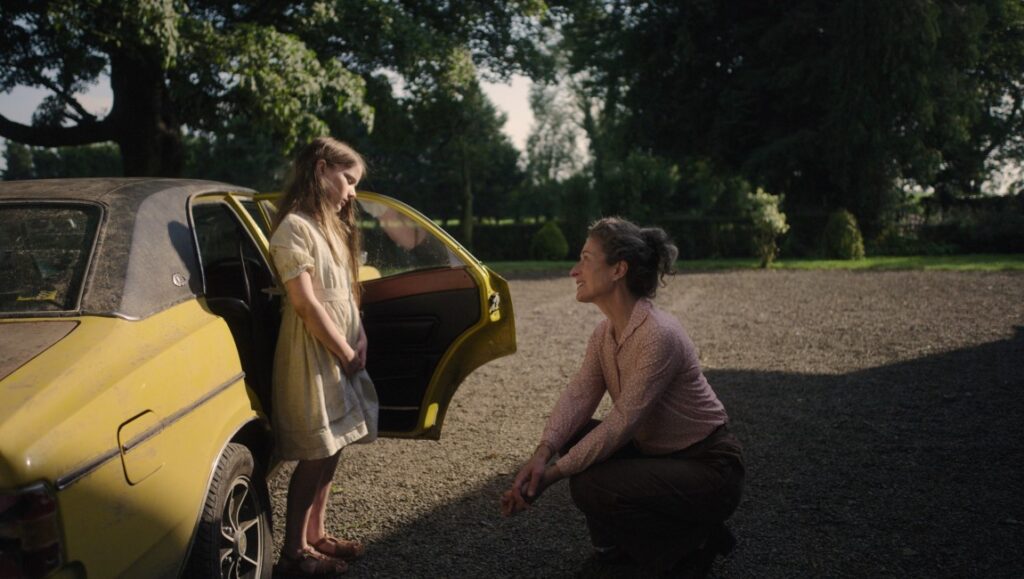Adapted from Claire Keegan’s novella Foster, out for over a decade in the author’s home Ireland but only just hitting U.S. shelves at the end of 2022, The Quiet Girl is the kind of film that viewers should meet with considerable trepidation. Keegan is unique in the literary landscape: her works conjure immense feeling despite, and through, the author’s economy of language, telling deeply human stories of everyday grief and toil and love without ever giving in to sentimentality or melodrama (see also: the utterly moving, [anti-]Christmas novella Small Things Like These). In other words, her’s are the kind of minimalist stories that filmmakers and studios typically seek to “punch up” with exaggerated emotion, missing the power possible in small tales of everyday folk, left unencumbered by applied histrionics.
Foster, and so by extension The Quiet Girl, details one summer in the life of Cáit, the eponymous nine-year-old. Living in poverty, with the house already overrun by children and Cáit’s mother in the final stretch of yet another pregnancy, the quiet girl is sent to stay with her mother’s cousin Eibhlín and her husband Seán for the summer. Established in these early scenes are a few things: the ambivalence, teetering into neglect, with which Cáit’s parents regard her (her father even drives away with her suitcase still in the car, leaving her with literally only the clothes on her back); the only barely contained but also confused joy that Eibhlín feels with Cáit now in their home; and Seán’s reticence to open himself up to the young girl’s presence. But these elements are left to subtlety, their origins only slowly revealed across the film’s 90 minutes, tragedies small and large alternately muted and enunciated by the deep relationships formed amongst the film’s central trio.
If Cáit is the quiet girl, then The Quiet Girl is also a quiet film. Director Colm Bairéad not only avoids the trap of maudlinizing the material, but fully embraces the soft fragility of Keegan’s source story, which is rooted in what’s left unsaid. Silences are here leveraged to speak to how those feelings haunt relationships and lives, fissures filled in by griefs and wants, margins colored by sorrows that are always past and future. Bairéad’s camera likewise expresses such delicacies: it’s always pushing in throughout the film, staying static when taking in the land’s pastoral grace or capturing bodies set against its beauty, but more often moving ever toward characters, establishing a visual language to articulate how trapped they all are within their circumstances, even in joy-infused montage sequences. Meanwhile, Cáit is both catalyst and witness throughout, sometimes a canvas and sometimes a salvation for Eibhlín and Seán, while in other moments offering a perspective for a film that also operates as a stealth portrait of marriage, and of unhealable family wounds. The concerns here are heavy and hard, but the touch is gentle.
The Quiet Girl is a film constructed of small, unassuming moments, and one that retroactively casts poignancy upon even its most minute interactions by the end. Wind is always rustling through trees and gentle harp soundtracks observations of daily living, but none of this is mere affectation; instead, it reflects an acute understanding of Keegan’s ethos and aims. Attention is never drawn to anything, which makes the film’s instances of profound power — like a late-film scene where Cáit returns home after the birth of her newest sibling, and after a summer of essential innocence lost, takes a literal seat at the table with the four adults in her life — hit so much harder than they would had they been underlined with the hysteria of enunciated emotionality. Restraint is the name of the game in The Quiet Girl, and Bairéad manages this kind of composure as well as any film in recent memory. Admittedly, there isn’t a lot of aesthetic weight to the project, but delivering a film that refuses to pander to the book club set’s need for bolded explication of emotion, and instead fully embraces a space of hazy interiority, is a far harder skill to execute than the humble master shot or bravura tracking sequence. The Quiet Girl is the strange film that thrives on an absence, keen in its understanding of how we’re conditioned to engage with and experience story, and radical in its refusal to kowtow to such facile whims. In understanding grief and pain as a fundamental, almost mundane, facet of existence, Bairéad’s film, like Keegan’s novella, is as quietly obliterating as they come.
Published as part of InRO Weekly — Volume 1, Issue 8.


Comments are closed.